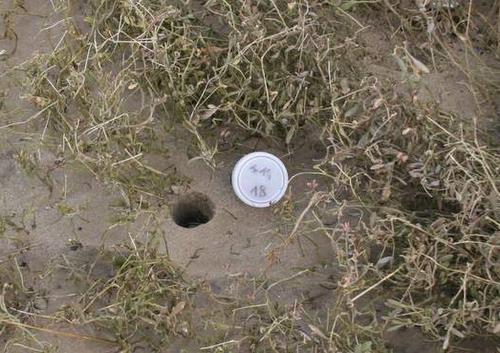Sampling Equipment
- bucket
- cups with a screw cap (such as urine cups)
- waterproof marker
- spoon (for scooping sand into cups)
- long knife (for sampling ground with roots)
- refractometer (to measure the salinity)
- sampling site description sheet
- pencil
- camera (ideally with GPS)
- camera
- scoop (a device that allows to collect species that live on aquatic vegetation)
General Advice
Take a picture of every sample (in order to identify the sample on the picture, write the sample number clearly on the lid of the cup). Document the general sampling area and jot down a brief description of each specific sample. It will make it a lot easier to locate the same sample location again in case you want to return to collect more individuals of a particular species (or if you want to sample similar sites in other locations). Also, try to take the GPS coordinates of each sample and/or sample location.
Sand Sample
A sand sample is a sample that collects sand in a small and clearly defined area. For such samples, it is useful to note the thickness of the oxygenated layer. We usually do not find macrostomids in evidently anoxic layers (often indicated by blackened sediment). Also try to avoid collecting a lot of black sediment in your sample, because it makes the samples go bad more quickly.

Pete Samples
A 'Pete Sample' is a long, thin surface sample covering a gradient over different substrates or habitats (the name is in honor of Peter Ladurner, who 'invented' that type of sample). Pete samples are very useful in a 'range finding' process, for example, when you collect in a place for the first time. If you find some worms in such a sample, you can always go back and sample on a more fine-grained scale.

Transects
Multiple Pete samples can be combined into long transects, to start obtaining a better idea about the spatial structure of the species distribution.

Scoop
To sample in between vegetation, especially in fresh water habitats, a scoop sampling device can be very helpful to collect and concentrate the material. This one was built by Gregor Schulte out of a discarded detergent container found on the beach, a 30 µm mesh and a lid of a urine cup. Basically, you need a sturdy funnel, ideally with a handle, and a fine mesh that holds back the animals, but lets through the water. The sampled material then collects in the bottom of the scoop in a detachable cup. It's really an indispensable collection tool. Note that scoops can also be very successfully used on a flooded meadow. An alternative to a scoop is to collect vegetation, and to shake it forcefully in a bucket of local habitat water. Both types of samples then are extracted using the bottle method (see Extraction).


Core Sample
These kinds of acrylic tubes are useful to take core samples in a more standardized way. However, many species tend to live quite superficially (at least species of the genus Macrostomum), and so taking deeper samples may not be so useful for species in this genus.

